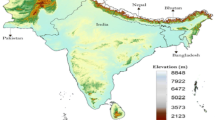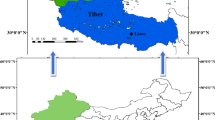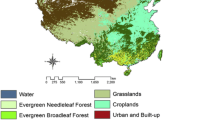Abstract
Drought is a severe climate fact that mainly results from low rainfall leading to serious threat of water shortages an ecological system of South Asia. Due to the current drought conditions and vegetation dynamics, the situation could further be intensified over South Asia. Thus, we study the drought impacts on vegetation dynamics over South Asia, aimed to find out the spatiotemporal differences in vegetation dynamics and seasons at which vegetation is determined by drought. Our approach is based on the using of advanced very high resolution radiometer (AVHRR) normalized difference vegetation index (NDVI) data and (NASA’s MERRA) air temperature and rainfall data (1990–2015). Due to the low vegetation and dryness in South Asia, the NDVI is more helpful in describing the drought condition. From April to October, there were fast improvements in NDVI, VHI, and VCI. During September, the monthly VHI and VCI were stabilized and enhanced in October once more and in December again indicated a declining trend. The PCI, TCI, VCI, and VHI monthly values confirmed that in 2001, an extreme drought year, and continuous up to 2003, which lead the maximum drought in the South Asia regions. A considerably significantly correlation value in summer (JJA) and autumn (SON) seasons are showed between precipitation and NDVI. While the relationship between NVSWI and NDVI presented considerably high relationship in DJF, JJA, and SON, which specify an excellent indication for monitoring water stress. From 1990 to 2015, the difference of vegetation trend was obvious showed among various regions. The drought frequency was reducing trends from 1990 to 2015 over South Asia.









Similar content being viewed by others
References
Abbas S, Nichol JE, Qamer FM, Xu J (2014) Characterization of drought development through remote sensing: a case study in central Yunnan, China. Remote Sens 6(6):4998–5018
Agrawala S, Barlow M, Cullen H, Lyou B (2001) Drought and humanitarian crisis in central and southwest asia: a climate perspectives. International Research for Climate and Society (IRI)), Palisades, p 20
Amin MO, Jan A, Mehrdada R, Ali M, Reza AS (2011) Drought monitoring methodology based on AVHRR images and SPOT vegetation maps. J Water Resour Prot 3:325–334
Bala G, Joshi J, Chaturvedi RK, Gangamani HV, Hashimoto H, Nemani R (2013) Trends and variability of AVHRR-derived NPP in India. Remote Sens 5(2):810–829
Campbell JB, Wynne RH (2011) Introduction to remote sensing (5th Edition). Guilford Press, New York, USA. Photogrammetric Record 28(141):117–118
Carlson TN, Gillies RR, Perry EM (1994) A method to make use of thermal infrared temperature and NDVI measurements to infer surface soil water content and fractional vegetation cover. Remote Sens Rev 9:161–173
Chen CF, Son NT, Chang LY, Chen CC (2011) Monitoring of soil moisture variability in relation to rice cropping systems in the Vietnamese Mekong Delta using MODIS data. Appl Geogr 31(2):463–475
Crow WT, Miralles DG, Cosh MH (2010) A quasi-global evaluation systemfor satellitebased surface soil moisture retrievals. IEEE Trans Geosci Remote Sens 48(6):2516–2527
de Jong RS, de Bruin A, de Wit ME, Schaepman, Dent DL (2011) Analysis of monotonic greening and browning trends from global NDVI time-series. Remote Sens Environ 115(2):692–702
Devaraju N, Bala G, Nemani R (2015) Modelling the influence of land-use changes on biophysical and biochemical interactions at regional and global scales. Plant Cell Environ. https://doi.org/10.1111/pce.12488
Forkel M, Carvalhais N, Verbesselt J, Mahecha MD, Neigh SRC, Reichstein M (2013) Trend change detection in NDVI time series: effects of inter-annual variability and methodology. Remote Sens 5:2113–2144
Ghulam A, Qin Q, Teyip T, Li ZL (2007) Modified perpendicular drought index (MPDI): a real-time drought monitoring method. ISPRS J Photogramm Remote Sens 62:150–164
Gouveia C, Trigo RM, DaCamara CC (2009) Drought and vegetation stress monitoring in Portugal using satellite data. Nat Hazards Earth Syst Sci 9:185–195
Holzman ME, Rivas R, Piccolo MC (2014) Estimating soil moisture and the relationship with crop yield using surface temperature and vegetation index. Int J Appl Earth Obs Geoinf 28:181–192
Hua T, Wang X, Ci Z, Lang L, Zhang C (2015) Responses of vegetation activity to climate variation on the Qinghai–Tibetan Plateau (China) from 1982 to 2011. Clim Res 66:65–73
Huang J, Xue Y, Sun S, Zhang J (2015) Spatial and temporal variability of drought during 1960–2012 in Inner Mongolia, north China. Quat Int 355:134–144
IPCC (2014) Climate change 2014: mitigation of climate change. In: Contribution of working group III to the fifth assessment report of the intergovernmental panel on climate change. Cambridge University Press, New York, pp 10013–2473
Ivits E, Horison S, Fenshold R, Cherlet M (2014) Drought footprint on European ecosystems between 1999 nd 2010 assessed by remotely sensed vegetation phenology and productivity. Glob Chang Biol 20:581–593
Jackson TJ, Cosh MH, Bindlish R, Starks PJ, Bosch DD, Seyfried M, Du J (2010) Validation of advanced microwave scanning radiometer soil moisture products. IEEE Trans Geosci Remote Sens 48(12):4256–4272
Jain SK, Keshri R, Goswami A, Sarkar A (2010) Application of meteorological and vegetation indices for evaluation of drought impact: a case study for Rajasthan, India. Nat Hazards 54(3):643–656
Jeyaseelan AT, Roy PS, Young SS (2007) Persistent changes in NDVI between 1982 and 2003 over India using AVHRR GIMMS (Global Inventory Modeling and Mapping Studies) data. Int J Remote Sens 28(21):4927–4946
Kadiyala MDM, Nedumaran S, Singh P, Chukka S, Irshad MA, Bantilan MCS (2015) An integrated crop model and GIS decision support for assisting agronomic decision making under climate change. Sci Total Environ 521–522:123–134
Karnieli A, Agam N, Pinker RT, Anderson M, Imhoff ML, Gutman GG, Panov N, Goldberg A (2010) Use of NDVI and land surface temperature for drought assessment: merits and limitations. J Clim 23(3):618–633
Kogan FN (1990) Remote sensing of weather impacts on vegetation in non-homogeneous areas. Int J Remote Sens 11:1405–1419
Kogan FN (1995) Application of vegetation index and brightness temperature for drought detection. Adv Space Res 15(11):91–100
Kogan FN (1998) A typical pattern of vegetation conditions in southern Africa during El Nino years detected from AVHRR data using three-channel numerical index. Int J Remote Sens 19:3688–3694
Lloret F, Lobo A, Estevan H, Maisongrande P, Vayreda J, Terradas J (2007) Woody plant richness and NDVI response to drought events in Catalonian (northeastern Spain) forests. Ecology 88:2270–2279
Maherali H, DeLucia EH (2001) Influence of climate-driven shifts in biomass allocation on water transport and storage in ponderosa pine. Oecologia 129:481–491
Nath R, Nath D, Li Q, Chen W, Cui X (2017) Impact of drought on agriculture in the indo-Gangetic plain, India. Adv Atmos Sci 34(3):335–346
NBS (2005) China statistical yearbook, 2004. National Bureau of Statistics of China Niemeyer S (2008) new drought indices. Options Mditerr Sri A Sminaires Mditer 80:267–274
Pandey S, Bhandari HN, Hardy B (2007) Economic costs of drought and rice farmers coping mechanisms: a cross-country comparative analysis. International Rice Research Institute, Los Baos
Pasho E, Camarero JJ, De Luis M, Vicente-Serrano SM (2012) Factors driving growth responses to drought in Mediterranean forests. Eur J For Res 131:1797–1807
Pettorelli N, Vik JO, Mysterud A, Gaillard J-M, Tucker CJ, Stenseth NC (2005) Using the satellite- derived NDVI to assess ecological responses to environmental change. Trends Ecol Evol 20(9):503–510
Rouse, J.W., R.H. Haas, J.A. Schell, D.W. Deering. 1973. Monitoring vegetation systems in the Great Plains with ERTS. In: Third earth resources technology satellite symposium NASA SP-351 I, pp 309–317
Rousvel S, Armand N, Andre L, Tengeleng S, Alain TS, Armel K (2013) Comparison between vegetation and rainfall of bioclimate eco-regions in Central Africa. Atmosphere 4:411–427
Sandholt I, Rasmussen K, Andersen J (2002) A simple interpretation of the surface temperature/vegetation index space for assessment of surface moisture status. Remote Sens Environ 79(2):213–224
Schillinger WF, Schofstoll SE, Alldredge JR (2008) Available water and wheat grain yield relations in a Mediterranean climate. Field Crop Res 109(1–3):45–49
Singh RP, Roy S, Kogan F (2003) Vegetation and temperature condition indices from NOAA AVHRR data for drought monitoring over India. Int J Remote Sens 24(22):4393–4402
Song X, Li L, Fu G, Li J, Zhang A, Liu W, Zhang K (2014) Spatial–temporal variations of spring drought based on spring-composite index values for the Songnen plain, Northeast China. Theor Appl Climatol 116(3–4):371–384
Tucker CJ (1979) Red and photographic infrared linear combinations for monitoring vegetation. Remote Sens Environ 8:127–150
Udelhoven T, Stellmes M, del Barrio G, Hill J (2009) Assessment of rainfall and NDVI anomalies in Spain (1989–1999) using distributed lag models. Int J Remote Sens 30(8):1961–1976
Wang J, Price KP, Rich PM (2001) Spatial patterns of NDVI in response to precipitation and temperature in the central Great Plains. Int J Remote Sens 22(18):3827–3844
White MA, Beurs D, Kirsten M, Didan K, Inouye DW, Richardson AD, Nemani RR (2009) Intercomparison, interpretation, and assessment of spring phenology in North America estimated from remote sensing for 1982–2006. Glob Chang Biol 15(10):2335–2359
Xu G, Zhang H, Chen B, Zhang H, Innes JL, Wang G, Yan J, Zheng Y, Zhu Z, Myneni RB (2014) Changes in vegetation growth dynamics and relations with climate over China’s land mass from 1982–2011. Remote Sens 6:3263–3283
Zhang J, Mu Q, Huang J (2016) Assessing the remotely sensed drought severity index for agricultural drought monitoring and impact analysis in North China. Ecol Indic 63:296–309
Zhou L, Wu J, Mo X, Zhou H, Diao C (2017) Quantitative and detailed spatiotemporal patterns of drought in China during 2001–2013. Sci Total Environ 589(1):136–145
Funding
This work was supported by the Key basic research project of Shandong natural science foundation of China (ZR2017ZB0422), the China Postdoctoral Science Foundation Project Funding (2018M642614), and “Taishan Scholar” project of Shandong Province.
Author information
Authors and Affiliations
Corresponding authors
Ethics declarations
Conflict of interest
The authors declare that they have no conflict of interest.
Additional information
Responsible editor: Philippe Garrigues
Publisher’s note
Springer Nature remains neutral with regard to jurisdictional claims in published maps and institutional affiliations.
Rights and permissions
About this article
Cite this article
Ali, S., Xu, Z.T., Henchirli, M. et al. Studying of drought phenomena and vegetation trends over South Asia from 1990 to 2015 by using AVHRR and NASA’s MERRA data. Environ Sci Pollut Res 27, 4756–4768 (2020). https://doi.org/10.1007/s11356-019-07221-4
Received:
Accepted:
Published:
Issue Date:
DOI: https://doi.org/10.1007/s11356-019-07221-4




